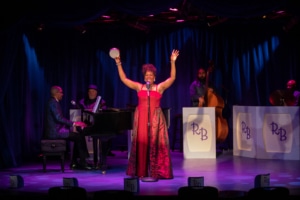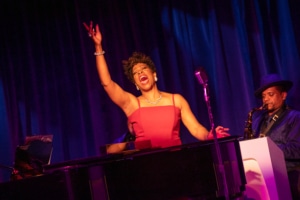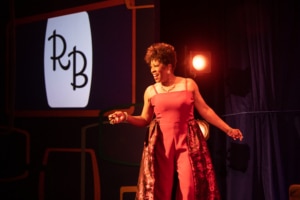DCPA NEWS CENTER
Enjoy the best stories and perspectives from the theatre world today.
Enjoy the best stories and perspectives from the theatre world today.
It’s a unique experience to witness a performance of Miss Rhythm – The Legend of Ruth Brown. It’s a combination of concert and musical, an effective piece of time-travel, transporting audiences back in time. But it isn’t just the music that does this – it’s the setting, the costumes, even the lighting.
DCPA Cabaret productions enlist a creative team that may include a set designer, lighting designer, costume designer, sound designer, and more. Miss Rhythm – The Legend of Ruth Brown features the work of all these creatives, plus a projection designer. Never heard of sound design? Or maybe you think a lighting designer just ‘turns on the lights’ for the show.
This production is supported by an all-local creative team. Read on to discover the creative process for each designer and why exactly they love their jobs so much.

Sheryl McCallum in Miss Rhythm – The Legend of Ruth Brown. Photo by McLeod9 Creative
For anyone who might not be familiar, can you explain what your job is?
El Armstrong, Projection Designer: Projection design is about adding visual elements (either still or motion) to a production to enhance the storytelling. Projections can be used in several different ways, but are often used to help set time, place and/or mood for a scene.
Charles R. MacLeod, Lighting Designer: A Lighting Designer in the theatre is responsible for creating/enhancing an environment for the physical production. I help guide the audience where to look and sometimes where not to look. This is all done through placement (focus), color, intensity and shadows (templates/gobos).
Max Silverman, Sound Designer: As the sound designer I am responsible for everything the audience hears from the moment they enter the theatre. For musicals this entails the mix and balance of musicians, singers and sound effects. With plays it is different. Here, I often compose music and add underscoring, which can help move the action along. It can also create a certain mood for a scene just as the score of a movie plays such an important role in the audience’s emotional experience.

Sheryl McCallum in Miss Rhythm – The Legend of Ruth Brown. Photo by McLeod9 Creative
Miss Rhythm – The Legend of Ruth Brown is a unique show, meant to feel like a Ruth Brown concert. What were some of the challenges with working in this style?
Meghan Anderson Doyle, Costume Designer: For Ruth Brown, I was able to look at tons of actual pictures of her actual life in performance, stylized fashion images of the era in Ebony magazines and historical images from across her lifetime. Our costume shop was able to modify some contemporary pieces to create a vintage look that has a quick-change element, and we added a wonderful vintage piece for the final look of the show. The band costume design came from a desire to have that sharp, big band feel with a nuanced individuality for each of the members.
Max Silverman: It was especially exciting and challenging because unlike a traditional musical where you have musicians in a pit, which is a much more controlled environment, we get to have our musicians on stage. Early on in the process I knew that my biggest goal and challenge would be to try to replicate the raw, live sound and energy that comes from seeing someone like Ruth Brown perform with her musicians in some of these legendary intimate clubs as well as larger theatres like the renowned Apollo Theatre in New York City.
Charles R. MacLeod: The creative team did not want the look of 2023 onstage – we wanted to go back to Ruth Browns’ era. We used vintage lighting fixtures onstage with hidden LED fixtures inside of them, so we had the best of both worlds — an old fixture with new lighting inside! Certainly, one could just “turn on the lights” and walk away as the primary purpose of lighting the stage is to see the performers. However, a more nuanced design allows an audience to home in on the action onstage and occasionally add to the emotional content.

Sheryl McCallum in Miss Rhythm – The Legend of Ruth Brown. Photo by McLeod9 Creative
Why do you love what you do?
El Armstrong: I really enjoy the variety of projects (and the variety of research) that I get to do. It’s also tremendously satisfying to see an audience have an “ah-ha” moment from your work
Meghan Anderson Doyle: Every day I get to make my living making art, creating characters, and collaborating with other artists to bring fully realized worlds to life on stage. I also love that I get to work with a wide variety of talented people across the field from directors to designers, actors, musicians, and technicians. It really takes a team effort to make great shows come together in a fun and meaningful way.
Charles R. MacLeod: I truly love the opportunity to light the stage. To craft moments of deep emotion. To help a set and costumes sparkle and come to life. To add a heightened sense of emotion for the actors and audiences, even if they might not be aware of how or why.
Max Silverman: One of my favorite aspects of being the sound designer is getting to facilitate the connection between what is happening on stage and our audience. Throughout the tech process it takes a lot of exploration and collaboration between our sound team, the musicians, singers and music director to get the best sound. Then, when everything comes together, I can finally see the impact that all of the elements of the show have on an audience. If that happens in the way I’d been hoping, it is incredibly exhilarating.
